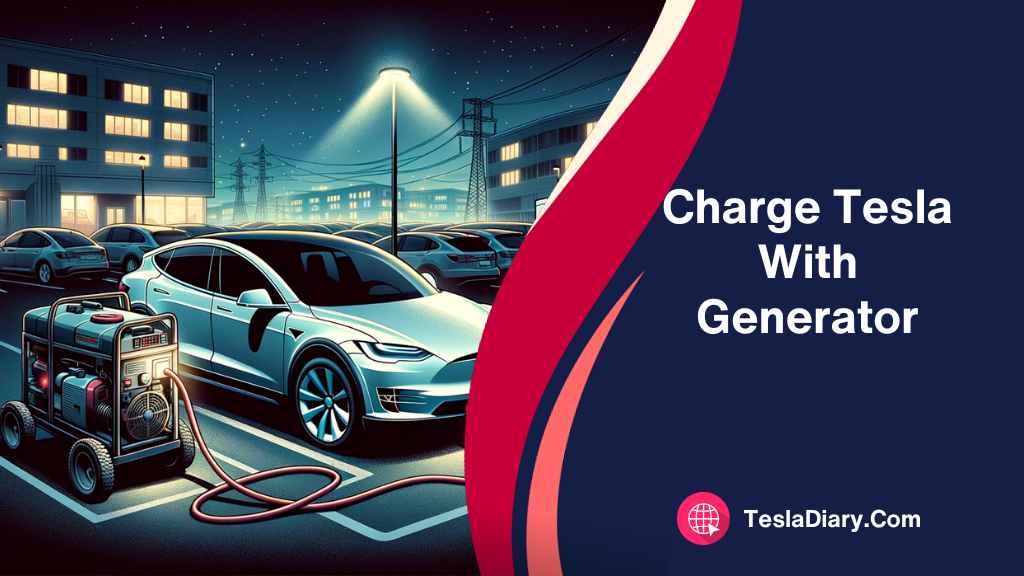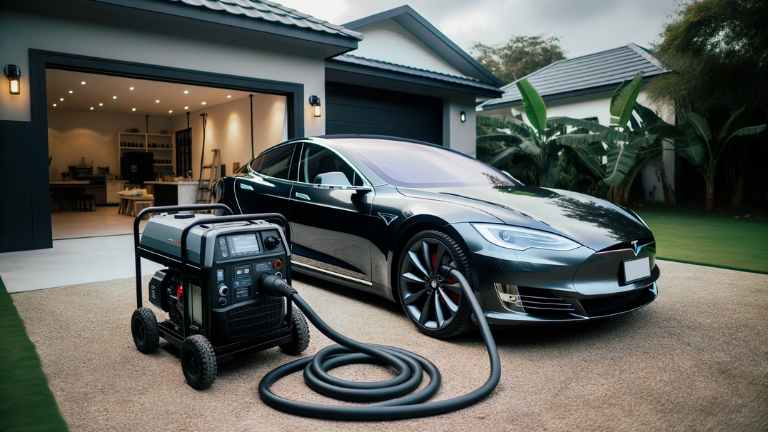Electric vehicles, especially Tesla, have gained significant popularity due to their eco-friendliness and cost-effectiveness. However, the challenge of finding a reliable charging source, particularly in remote areas or during power outages, can be daunting.
In such situations, using a generator to charge your Tesla can be a lifesaver. This comprehensive guide will walk you through the entire process, ensuring a safe and efficient charging experience.
Choosing the Right Generator
Selecting the right generator is crucial to ensure efficient charging. Here’s how to make an informed choice:

Assessing Power Requirements
Determine Your Tesla’s Battery Capacity: Check your Tesla’s battery capacity to estimate the energy required for a full charge. This information can be found in your vehicle’s manual or on the Tesla app.
| Tesla Model | Battery Capacity (kWh) |
|---|---|
| Model S | |
| – Long Range | Approximately 100 kWh |
| – Plaid | Approximately 100 kWh |
| Model 3 | |
| – Standard Range | Approximately 54 kWh |
| – Long Range RWD | Approximately 82 kWh |
| – Long Range AWD | Approximately 82 kWh |
| – Performance | Approximately 82 kWh |
| Model X | |
| – Long Range | Approximately 100 kWh |
| – Plaid | Approximately 100 kWh |
| Model Y | |
| – Long Range RWD | Approximately 75 kWh |
| – Long Range AWD | Approximately 75 kWh |
| – Performance | Approximately 75 kWh |
Calculate Charging Time: Calculate the time it will take to charge your Tesla fully. Keep in mind that charging times may vary based on your generator’s power output.
Generator Selection Criteria
Power Output (kW): Your generator must produce enough power to meet your Tesla’s charging needs. A good rule of thumb is to choose a generator with at least double the power output of your Tesla charger.
| Tesla Charging Solution | Power Output Required |
|---|---|
| Tesla Supercharger | Varies, typically 120 kW to 250 kW |
| Tesla Wall Connector | Upto 11.5 kW |
| Tesla Mobile Connector | Upto 7.6 kW |
Fuel Type: Generators can run on gasoline, propane, or diesel. Select a fuel type that suits your preferences and availability.
Portability and Convenience: Consider the generator’s portability and how easily you can transport it to different locations, especially if you plan to use it for on-the-go charging.
Preparing Your Generator
Properly preparing your generator ensures a smooth and safe charging process.
Generator Maintenance and Readiness
Fuel Level and Quality: Ensure your generator has enough fuel of the appropriate quality. Stale or contaminated fuel can damage your generator and hinder its performance.
Oil Level and Changes: Regularly check the generator’s oil level and adhere to the manufacturer’s recommended oil change intervals.
Checking for Carbon Monoxide Emissions: Generators emit carbon monoxide, a deadly gas. Place your generator in a well-ventilated outdoor area away from living spaces, and consider using a carbon monoxide detector.
Generator Placement
Safe and Well-Ventilated Location: Set up your generator in a safe, well-ventilated area. Avoid enclosed spaces, garages, or areas with poor ventilation to prevent carbon monoxide buildup.
Distance from the Tesla and Other Structures: Maintain a safe distance between the generator, your Tesla, and any nearby structures to reduce the risk of accidents or fires.
Connecting the Generator to Your Tesla
With your generator ready, it’s time to connect it to your Tesla for charging.
Gathering Necessary Equipment
Tesla Charging Cable: Ensure you have the correct Tesla charging cable for your vehicle. Tesla provides adapters for various outlets, so make sure you have the appropriate ones.
You should use the Tesla wall connector for the best result if the generator has the capacity. If not, a mobile connector will do.

Appropriate Adapters: Depending on your generator’s outlet type, you may need adapters to connect the Tesla charging cable.
Connecting the Generator
Identify the Generator’s Power Outlet: Locate the power outlet on your generator. It may be a 120V or 240V outlet, so ensure compatibility with your Tesla’s charging cable.
120V outlet will allow you to charge at 3 to 4 miles range per hour with a mobile connector whereas a 240-volt wall connector will provide 44 miles of range per hour.
Secure Connection: Connect the Tesla charging cable securely to the generator’s outlet, making sure it’s firmly seated.
Starting the Generator
Starting and monitoring the generator properly is essential for a successful charging session.
Fueling and Starting the Generator
Follow Manufacturer’s Instructions: Always follow the manufacturer’s instructions for fueling and starting the generator. This typically involves turning the fuel valve to “On,” setting the choke (if applicable), and pulling the starter cord or pressing the electric start button.
Stable Power Output: Ensure the generator is running smoothly and providing a stable power output by checking the voltage and frequency readings on the generator’s control panel.
Monitoring the Generator
- Keep an Eye on Fuel Levels: Continuously monitor the generator’s fuel levels. Running out of fuel during a charging session can interrupt the process.
- Addressing Issues: Be prepared to address any issues or fluctuations in the generator’s performance promptly. Common issues may include overheating, low oil levels, or voltage irregularities.
Charging Your Tesla
With the generator running, you can now initiate the charging process for your Tesla.
Initiating the Charging Process
Activate the Tesla Charger: Start the charging process using the Tesla charger connected to your vehicle. Plug the charging cable into your Tesla’s charging port.
Monitoring the Charging Progress: Keep an eye on your Tesla’s charging status through the Tesla app or your vehicle’s touchscreen. You should see information on the charging rate and estimated time to full charge.
Safety Precautions During Charging
Stay Nearby and Attentive: Remain close to your Tesla and the generator while it’s charging. Be attentive to any unusual sounds, smells, or warning lights.
Handling Emergencies or Interruptions: Have a plan in place for handling emergencies or interruptions in the charging process. This could involve shutting down the generator, unplugging the charging cable, or contacting Tesla support.
Completing the Charging Process
As your Tesla charges, it’s crucial to know when it’s fully charged and how to safely disconnect the generator.
Determining When Your Tesla Is Fully Charged
- Monitoring the Charging Rate: Keep an eye on the charging rate to estimate when your Tesla will be fully charged. The rate may slow down as the battery reaches capacity.
- Tesla App Notifications: Utilize the Tesla app to receive notifications about your vehicle’s charging status. The app will alert you when the charging session is complete.
Disconnecting the Generator
- Safely Turn Off the Generator: Follow proper shutdown procedures for the generator. Typically, this involves turning off the fuel valve, letting the engine run for a few minutes to cool down, and then turning off the generator.
- Disconnecting the Charging Cable: Carefully disconnect the Tesla charging cable from the generator’s outlet. Ensure that the generator is entirely turned off before doing so to prevent electrical hazards.
Q1: What kind of generator will charge a Tesla?
A1: To charge a Tesla effectively, you’ll need a generator with sufficient power output. Generally, a generator with a power output of at least 7 kW (kilowatts) is recommended for charging a Tesla. Portable generators, standby generators, or generators designed for RV use are suitable options, but the power output should match your Tesla’s charging requirements.
Q2: How fast will a generator charge a Tesla?
A2: The charging speed of a Tesla with a generator depends on the generator’s power output and your vehicle’s charging capacity. As a rough estimate, a 10 kW generator can provide around 10-20 miles of range per hour of charging. The specific charging time will vary based on factors like the Tesla model and the generator’s power output.
Q3: Is backup power for your EV practical?
A3: Backup power for your electric vehicle (EV) can be practical, especially in emergency situations or remote locations. Standby generators or renewable energy sources like solar and wind generators can serve as reliable backup power sources for EV charging.
Q4: Can you use a portable generator to charge an electric car?
A4: Yes, portable generators can be used to charge an electric car, including a Tesla. However, it’s crucial to ensure that the generator’s power output matches your vehicle’s charging requirements and that you follow safety precautions, such as using the generator in a well-ventilated outdoor area.
Q5: Is it safe to charge an electric car with a generator?
A5: Charging an electric car with a generator is safe when proper safety precautions are taken. Ensure the generator is used outdoors in well-ventilated areas to prevent carbon monoxide buildup. Follow the manufacturer’s instructions for both the generator and the electric car to ensure safety.
Q6: How many watts does it take to charge a Tesla?
A6: The power required to charge a Tesla varies depending on the model and the charging speed. For example, a standard Tesla Model 3 Long Range might require approximately 7.7 kW to charge at its maximum rate using a Level 2 charger.
Q7: How big of a generator is needed to charge a Tesla?
A7: The size of the generator needed to charge a Tesla depends on the Tesla model and your desired charging speed. A generator with a power output of at least 7 kW is recommended for most Tesla models. However, for faster charging, you might require a generator with a higher power output.
Q9: Can a Tesla Powerwall be charged by a generator?
A9: Yes, a Tesla Powerwall can be charged by a generator, especially during power outages or when renewable energy sources like solar panels are unavailable. The Powerwall can store excess energy generated by the generator for later use.
Q10: Can a Tesla charge at 22 kW AC?
A10: Tesla vehicles typically have onboard chargers with capacities ranging from 7 kW to 19.2 kW for AC charging, depending on the model. While some public charging stations offer 22 kW AC charging, not all Tesla models can utilize this full charging speed due to hardware limitations. The charging rate also depends on the Tesla’s compatibility with the station’s power output.
Conclusion
Charging your Tesla with a generator is a viable solution in situations where traditional charging methods are unavailable.
However, I recommend charging the Tesla enough with the generator so that you can recharge the car fully in a Supercharger. It is not ideal to rely on generators for all charging needs of your Tesla. If you are doing this, there is no point in having an electric vehicle instead of a gasoline-run vehicle.
By following this comprehensive guide and adhering to safety precautions, you can ensure a seamless and secure charging experience for your electric vehicle. Remember that safety should always be your top priority when charging your Tesla with a generator.
Always consult the manufacturer’s guidelines and recommendations for both your Tesla and the generator to ensure a successful and worry-free charging experience. Enjoy the convenience of charging your Tesla wherever your adventures take you!

